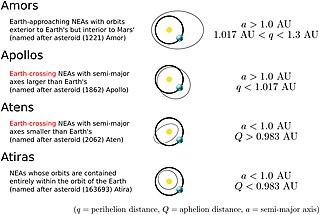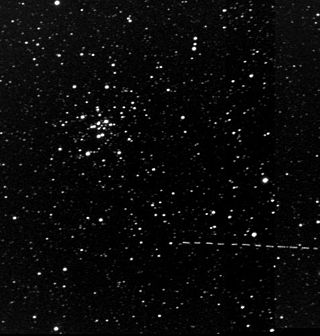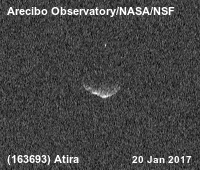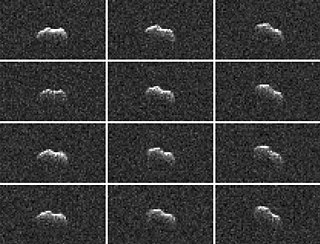Related Research Articles

The Aten asteroids are a dynamical group of asteroids whose orbits bring them into proximity with Earth. By definition, Atens are Earth-crossing asteroids (a < 1.0 AU and Q > 0.983 AU). The group is named after 2062 Aten, the first of its kind, discovered on 7 January 1976 by American astronomer Eleanor Helin at Palomar Observatory. As of November 2023, 2,646 Atens have been discovered, of which 256 are numbered, 14 are named, and 102 are classified as potentially hazardous asteroids.
(434326) 2004 JG6, provisional designation 2004 JG6, is an eccentric, sub-kilometer sized asteroid, classified as near-Earth object and potentially hazardous asteroid of the Atira group. It is one of the closest orbiting objects to the Sun. While its perihelion lies within the orbit of Mercury its orbital trajectory is highly elliptical, causing its aphelion to cross the orbit of Venus. Therefore, it does not fit the criteria for a vulcanoid or ꞋAylóꞌchaxnim asteroid, which would require it have a wholly intra-Mercurian and intra-Venusian orbit respectively.

(33342) 1998 WT24 is a bright, sub-kilometer asteroid, classified as near-Earth object and potentially hazardous asteroid (PHA) of the Aten group, located in Venus's zone of influence that has frequent close encounters with Mercury, Venus, and Earth. It made a close approach to Earth on 11 December 2015, passing at a distance of about 4.2 million kilometers (2.6 million miles, 11 lunar distances) and reaching about apparent magnitude 11.

524522 Zoozve (provisional designation 2002 VE68) is a sub-kilometer sized asteroid and temporary quasi-moon of Venus. Discovered in 2002, it was the first such object to be discovered around a major planet in the Solar System. It has nearly the same orbital period around the Sun that Venus does. In a frame of reference rotating with Venus, it appears to travel around it during one Venerean year, but it orbits the Sun, not Venus.

3752 Camillo is an inclined contact-binary asteroid, classified as near-Earth object of the Apollo group, approximately 2.3 kilometers in diameter. It was discovered on 15 August 1985, by astronomers Eleanor Helin and Maria Barucci using a 0.9-metre (35 in) telescope at the CERGA Observatory in Caussols, France. Lightcurve studies by Petr Pravec in 1998 suggest that the assumed S-type asteroid has an elongated shape and a longer-than average rotation period of 38 hours.

163693 Atira (; provisional designation 2003 CP20) is a stony asteroid, dwelling in the interior of Earth's orbit. It is classified as a near-Earth object. Atira is a binary asteroid, a system of two asteroids orbiting their common barycenter. The primary component with a diameter of approximately 4.8 kilometers (3 miles) is orbited by a minor-planet moon that measures about 1 km (0.6 mi). Atira was discovered on 11 February 2003, by astronomers with the Lincoln Near-Earth Asteroid Research at Lincoln Laboratory's Experimental Test Site near Socorro, New Mexico, in the United States.
2012 XE133 is an asteroid, classified as near-Earth object of the Aten group that is a temporary co-orbital of Venus.
2013 ND15 (also written 2013 ND15) is an asteroid that is a temporary trojan of Venus, the first known Venus trojan.
(374158) 2004 UL is a sub-kilometer asteroid on an outstandingly eccentric orbit, classified as near-Earth object and potentially hazardous asteroid of the Apollo group. The object is known for having the second-smallest perihelion of any known asteroid, after (137924) 2000 BD19.
(386454) 2008 XM is a highly eccentric, sub-kilometer-sized asteroid, with one of the smallest known perihelions among all minor planets. It is classified as near-Earth object of the Apollo group and was discovered on 2 December 2008, by the LINEAR program at Lincoln Laboratory's Experimental Test Site in Socorro, New Mexico, United States.
(456938) 2007 YV56, provisional designation 2007 YV56, is a sub-kilometer asteroid on an eccentric orbit, classified as a near-Earth object and potentially hazardous asteroid of the Apollo group, approximately 190–360 meters (620–1,200 ft) in diameter. It was discovered on 31 December 2007, by astronomers of the Catalina Sky Survey conducted at the Catalina Station in Arizona, United States.
(16960) 1998 QS52 (provisional designation 1998 QS52) is a stony asteroid on a highly eccentric orbit, classified as near-Earth object and potentially hazardous asteroid of the Apollo group, approximately 4.1 kilometers (2.5 mi) in diameter. It was discovered on 25 August 1998, by astronomers of the LINEAR program at Lincoln Laboratory's Experimental Test Site near Socorro, New Mexico, in the United States. This asteroid is one of the largest potentially hazardous asteroid known to exist.
(85182) 1991 AQ is a stony asteroid on a highly eccentric orbit, classified as near-Earth object and potentially hazardous asteroid of the Apollo group, approximately 1.1 kilometers in diameter. It was discovered on 14 January 1991, by American astronomer Eleanor Helin at the Palomar Observatory in California. Based on its brightness variation of 0.69 magnitude, this Q-type asteroid is likely elongated. It belongs to the small group of potentially hazardous asteroids larger than one kilometer.

594913 ꞌAylóꞌchaxnim (provisional designation 2020 AV2) is a large near-Earth asteroid discovered by the Zwicky Transient Facility on 4 January 2020. It is the first asteroid discovered to have an orbit completely within Venus's orbit, and is thus the first and only known member of the eponymous ꞌAylóꞌchaxnim (informally named Vatira before its discovery) population of Atira-class asteroids. ꞌAylóꞌchaxnim has the smallest known aphelion and third-smallest known semi-major axis among all asteroids. With an absolute magnitude approximately 16.2, the asteroid is expected to be larger than 1 km in diameter.
2019 BE5 is a sub-kilometer near-Earth asteroid classified under the Aten group. It was discovered on 31 January 2019, by the Zwicky Transient Facility at the Palomar Observatory. The asteroid was discovered one day after it had made a close approach to Earth from a distance of 0.00784 AU (1.173 million km; 3.05 LD).
2020 VT4 is a tiny near-Earth asteroid that passed 370 km (230 mi) above Earth's surface on 13 November 2020 at 17:20 UTC. The asteroid was discovered by the Asteroid Terrestrial-impact Last Alert System (ATLAS) survey at the Mauna Loa Observatory fifteen hours after its closest approach to Earth. The Earth encounter perturbed the asteroid's trajectory from an Earth-crossing Apollo-type orbit to an Aten-type orbit, subsequently reducing the asteroid's heliocentric orbital period from 1.5 years to 0.86 years.
2020 SW is a tiny near-Earth asteroid discovered by the Mount Lemmon Survey on 18 September 2020, six days before it made its closest approach to Earth. The asteroid passed within 21,600 kilometres (13,400 mi) from Earth's surface on 24 September 2020 11:13 UT, within the geostationary altitude of 36,000 kilometres (22,000 mi). The encounter with Earth perturbed the asteroid's heliocentric trajectory from an Apollo-type orbit to an Aten-type orbit with a semi-major axis within one astronomical unit from the Sun. As a result, the asteroid will not make any close approaches to Earth within 0.01 astronomical units (4 LD) in the next 200 years.

(231937) 2001 FO32 is a near-Earth asteroid classified as a potentially hazardous asteroid of the Apollo group. With an estimated diameter around 550 m (1,800 ft), it was discovered by the Lincoln Near-Earth Asteroid Research at Socorro, New Mexico on 23 March 2001. The asteroid safely passed by Earth on 21 March 2021 16:03 UTC from a closest approach distance of 0.0135 AU (2.02 million km; 1.25 million mi), or 5.25 lunar distances (LD). During the day before closest approach, 2001 FO32 reached a peak apparent magnitude of 11.7 and was visible to ground-based observers with telescope apertures of at least 20 cm (8 in). It is the largest and one of the fastest asteroids to approach Earth within 10 LD (3.8 million km; 2.4 million mi) in 2021.
2021 PH27 is a near-Earth asteroid of the Atira group. It was discovered by Scott Sheppard using the Dark Energy Survey's DECam imager at NOIRLab's Cerro Tololo Inter-American Observatory on 13 August 2021. 2021 PH27 has the smallest semi-major axis and shortest orbital period among all known asteroids as of 2021, with a velocity at perihelion of 106 km/s (240,000 mph). It also has the largest relativistic perihelion shift of any object orbiting the Sun, 1.6 times that of Mercury. With an absolute magnitude of 17.7, the asteroid is estimated to be larger than 1 kilometer (0.6 miles) in diameter.
References
- 1 2 3 4 5 6 7 "JPL Small-Body Database Browser: 99907 (1989 VA)" (2015-12-31 last obs.). Jet Propulsion Laboratory . Retrieved 1 June 2017.
- 1 2 3 "99907 (1989 VA)". Minor Planet Center. Retrieved 3 December 2015.
- 1 2 3 4 "LCDB Data for (99907)". Asteroid Lightcurve Database (LCDB). Retrieved 3 December 2015.
- 1 2 3 Campins, Humberto; Kelley, Michael S.; Fernández, Yanga; Licandro, Javier; Hargrove, Kelsey (September 2009). "Low Perihelion Near-Earth Asteroids". Earth. 105 (2–4): 159–165(EM&PHomepage). Bibcode:2009EM&P..105..159C. doi:10.1007/s11038-009-9310-2. S2CID 119771719 . Retrieved 3 December 2015.
- 1 2 Pravec, P.; Wolf, M.; Sarounová, L.; Mottola, S.; Erickson, A.; Hahn, G.; Harris, A. W.; Harris, A. W.; Young, J. W. (December 1997). "The Near-Earth Objects Follow-Up Program". Icarus. 130 (2): 275–286. Bibcode:1997Icar..130..275P. doi:10.1006/icar.1997.5816 . Retrieved 3 December 2015.
- 1 2 List Of Aten Minor Planets
- ↑ Christou, Apostolos A. (March 2000). "A Numerical Survey of Transient Co-orbitals of the Terrestrial Planets". Icarus. 144 (1): 1–20. Bibcode:2000Icar..144....1C. doi:10.1006/icar.1999.6278 . Retrieved 3 December 2015.
- ↑ de la Fuente Marcos, C.; de la Fuente Marcos, R. (June 2013). "Asteroid 2012 XE133: a transient companion to Venus". Monthly Notices of the Royal Astronomical Society. 432 (2): 886–893. arXiv: 1303.3705 . Bibcode:2013MNRAS.432..886D. doi: 10.1093/mnras/stt454 .
- ↑ "MPC/MPO/MPS Archive". Minor Planet Center. Retrieved 24 February 2018.